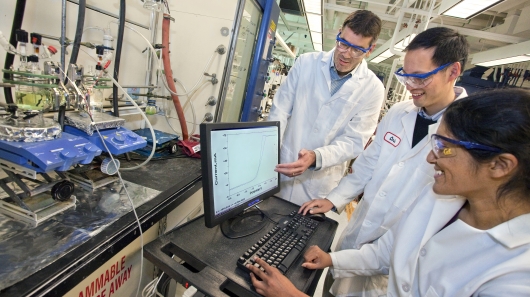Inexpensive metal catalyst discovered for electrolytic production of hydrogen from water
By Gizmag Team
06:29 May 3, 2010

The hydrogen economy that may one day replace the hydrocarbon economy came a step closer this week with the announcement that researchers have discovered an inexpensive new proton reduction catalyst - seventy times cheaper than the platinum commonly used now - that can significantly reduce the costs of producing hydrogen using electrolysis to split water into molecules of hydrogen and oxygen.
The important step was discovered by a team of researchers with the U.S. Department of Energy's (DOE) Lawrence Berkeley National Laboratory (Berkeley Lab) and the University of California, Berkeley. "Our catalyst does not require organic additives, and can operate in neutral water, even if it is dirty, and can operate in sea water, the most abundant source of hydrogen on earth and a natural electrolyte," said Hemamala Karunadasa, one of the co-discoverers of this complex. "These qualities make our catalyst ideal for renewable energy and sustainable chemistry."
Karunadasa holds joint appointments with Berkeley Lab's Chemical Sciences Division and UC Berkeley's Chemistry Department. She is the lead author of a paper describing this work that appears in the April 29, 2010 issue of the journal Nature, titled "A molecular molybdenum-oxo catalyst for generating hydrogen from water." Co-authors of this paper were Christopher Chang and Jeffrey Long, who also hold joint appointments with Berkeley Lab and UC Berkeley.
Hydrogen gas, whether combusted or used in fuel cells to generate electricity, emits only water vapor as an exhaust product, which is why this nation would already be rolling towards a hydrogen economy if only there were hydrogen wells to tap. However, hydrogen gas does not occur naturally and has to be produced.
Nature has developed extremely efficient water-splitting enzymes – called hydrogenases – for use by plants during photosynthesis, however, these enzymes are highly unstable and easily deactivated when removed from their native environment. Human activities demand a stable metal catalyst that can operate under non-biological settings.
Metal catalysts are commercially available, but they are low valence precious metals whose high costs make their widespread use prohibitive. For example, platinum, the best of them, costs some US$2,000 an ounce.
"The basic scientific challenge has been to create earth-abundant molecular systems that produce hydrogen from water with high catalytic activity and stability," Chang says. "We believe our discovery of a molecular molybdenum-oxo catalyst for generating hydrogen from water without the use of additional acids or organic co-solvents establishes a new chemical paradigm for creating reduction catalysts that are highly active and robust in aqueous media."
The molybdenum-oxo complex that Karunadasa, Chang and Long discovered is a high valence metal with the chemical name of (PY5Me2)Mo-oxo. In their studies, the research team found that this complex catalyzes the generation of hydrogen from neutral buffered water or even sea water with a turnover frequency of 2.4 moles of hydrogen per mole of catalyst per second.
Long says, "This metal-oxo complex represents a distinct molecular motif for reduction catalysis that has high activity and stability in water. We are now focused on modifying the PY5Me ligand portion of the complex and investigating other metal complexes based on similar ligand platforms to further facilitate electrical charge-driven as well as light-driven catalytic processes. Our particular emphasis is on chemistry relevant to sustainable energy cycles."
Copyright © gizmag 2003 - 2010 To subscribe or visit go to: http://www.gizmag.com